American infantry anti-tank weapons (part of 1)
Shortly before the outbreak of World War II, there was no specialized anti-tank in the American army. weapons. Fight with tanks the enemy was assigned to field artillery, which in its main part was very outdated.
In addition to field guns, it was planned to use the old 37-mm assault infantry guns M1916, originally created for artillery support for the advancing infantry, destruction of firing points and destruction of light fortifications, to combat armored vehicles. This cannon is the American version of Puteau’s French 37-mm trench gun, created during the First World War to combat machine gun nests and field fortifications. The gun weighed a little more than 100 kg and could be transported in separate packs: the swinging part — 40 kg, the machine — 40 kg, and the other parts — 28 kg. Effective fire on embrasures of the bunkers was ensured at a distance of up to 1200 meters. Combat firing rate - up to 15 rds / min. A solid blunt-headed armor-piercing projectile with a mass of 560 g left the barrel with an initial speed of 400 m / s, and at a short range could pierce more than 50 cm of tamped soil covered with wooden inch boards.
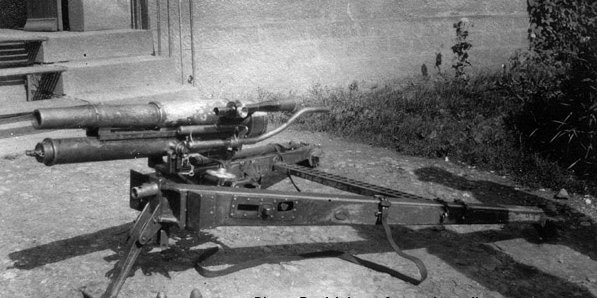
The characteristics of the armor-piercing projectile on the steel armor plate are unknown, it can be assumed that at the 200 distance I was “in the teeth” was 15 mm armor. But in any case, in the 30 of the last century, the 37-mm infantry cannon was a hopelessly outdated model, unable to withstand advanced tanks.
Before 1940, only large-caliber 12,7-mm Browning M2НВ machine guns were in service with anti-tank infantry regiments. Infantry modification of the air-cooled machine gun and tripod machine was adopted in 1933 year. Given that in 30-ies light tanks prevailed in the armed forces of most states, the Browning heavy machine gun could be considered a fairly effective weapon. The characteristics of the .50 BMG (12,7 × 99-mm) ammunition allowed for the 20-300 m to penetrate the frontal armor of light tanks. Thus, the 1 bullet with a mass of 48,6 g with a core of hardened carbon steel, put into service in the 1931 year, had an initial speed of 810 m / s, and could penetrate 250 mm armor at a distance of 20 m along the normal. When shooting with 100 m, armor penetration increased to 25 mm. It is worth recalling that the thickness of the frontal armor of the "export" British light tank Vickers Mk E (also known as the "Vickers six-ton") and created on its basis of the Soviet T-26 and Polish 7TP did not exceed 16 mm.
The Browning heavy machine gun proved to be a very successful and versatile means of dealing with light armored vehicles, it could also be successfully used against enemy personnel at long distances, suppress firing points and be used in military air defense. However, with the body weight of the 38,2 kg machine gun and the machine that weighed more than 20 kg, it was quite burdensome to transport the weapon even when disassembled over long distances.
At the end of the 30-ies an attempt was made to create on the basis of the Browning M2НВ machine gun a light anti-tank weapon of the battalion and company commander. In this way, the US tried to eliminate the main drawback of the machine gun - excessive weight for an infantry weapon. The anti-tank gun inherited the principle of operation of automation due to recoil with a short stroke of the weapon. Locking the barrel was carried out by a wedge, which moves in a vertical plane depending on the position of the barrel of the weapon. To reduce the recoil anti-tank gun got a spring-loaded butt. The fire was fought on a bipod. The main part of the details of the weapon was taken from the machine gun without any changes, which in turn had a negative effect on the mass.
A pistol grip was used to control the fire; fire could only be fired by single shots. The power of the weapon was carried out using a standard machine-gun belt. Snugging was done through a diopter sight. The weight without ammunition was 34 kg - that is, the 12,7-mm anti-tank semi-automatic rifle weighed about the same as the machine gun M2НВ without a machine. In fact, it was a large-caliber machine gun on a bipod, capable of firing only single shots. For testing, several prototypes, differing in design and barrel length, were created; they all turned out to be very cumbersome and heavy. Although the reliability of the automation did not cause any complaints, the army command did not consider it appropriate to adopt this model. The mass and dimensions of the weapon made it little mobile, and the characteristics of armor penetration allowed to fight only with light tanks. In addition, the weapon was quite expensive, its cost for mass production would be no less than $ 600. In 1940, the US Army bought M1 Garand rifles for $ 85 per unit. Experiments with the British 13,97-mm PTR Boys did not satisfy the American military. Although several hundred anti-tank rifle ships entered the Marine Corps anti-tank companies, a weapon piercing an inch armor plate at a distance of 100 m could no longer be considered a reliable means of fighting tanks possessing counter armor.
The American infantry needed a simple, inexpensive and massive anti-tank weapon, exceeding in range the use of hand-to-hand grenades. Shortly before the start of the Second World War, the M7 rifle fragmentation grenade was adopted. A grenade using a special 22-mm adapter, also designated the M7, was mounted on the rifle barrel. The shape of the grenade resembled a mortar mine and was fired by a blank cartridge. In 1942, the production of the M9 anti-tank rifle grenade with a cumulative warhead began.
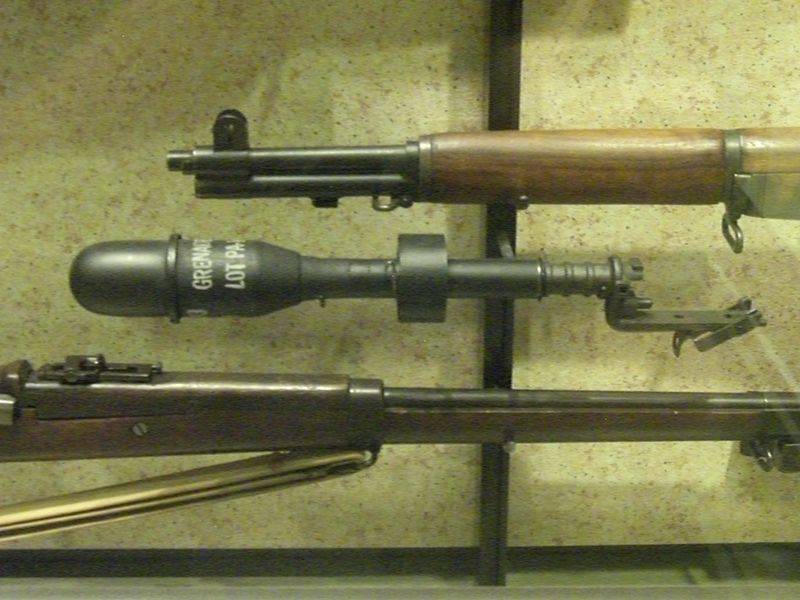
A garnet with a case diameter of 51-mm and a mass of 590 g contained 119 g of pentolite. However, soon after the start of deliveries to the troops, it became clear that the head fuse of a grenade is not always reliable and safe, and it also does not provide an optimal layout with respect to the shaped charge. In connection with this, the grenade was modernized and supplied with a ground fuse and a ballistic cap. After which she received the designation МХNUMXА9.
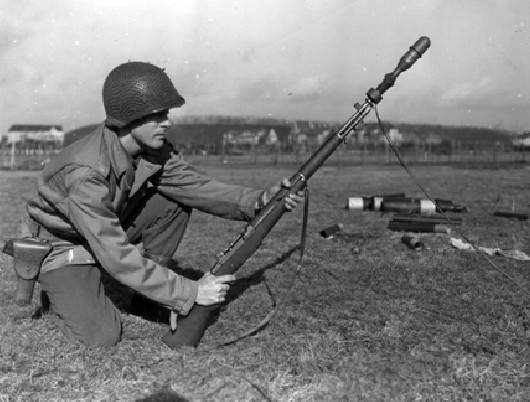
When fired from M1 Garand rifles and Springfield M1903, the grenade received an initial speed of 55 m / s and when launched at an angle of 45 ° flew to 250 m. However, the effective firing range of the armored vehicles did not exceed 70 m. mm armor, which was not enough for the reliable defeat of the average German tanks. However, by August 9 had released more than 1 million M50 and M1945A2,5 grenades and had been used very successfully against lightly armored Japanese tanks. Initially, the US Army was supposed to have one rocket launcher in the infantry, but in 9 this number increased to 9-1 riflemen with rifle grenade launchers. In the USMC, before landing on the Pacific Islands, approximately 1944% of shooters were armed with rifles with muzzle nozzles. After the end of the war, M2 grenade launchers with M3А25 grenades were supplied to the US allies with M1 Garand American rifles. During the war in Korea and Southeast Asia, these weapons were captured in significant quantities by North Korean troops, Chinese volunteers and Vietnamese partisans. The M7А9 grenades proved to be ineffective against tanks, but armored personnel carriers, reconnaissance armored vehicles and trucks struck confidently.
The calculations showed that in order for a cumulative grenade to be able to penetrate the frontal armor of an average tank, its caliber must be increased to 57-60-mm, and at least 200 g of powerful explosives should be used. As a result, an 60-mm M10 rifle grenade with a mass of about 1500 g was born, in the warhead of which 220 g of pentolite was contained behind the cumulative funnel. When hit at right angles, a shaped charge could penetrate 90 mm armor. However, it soon became clear that the sighting range using standard 22-mm muzzle nozzle and a blank cartridge does not guarantee the personal safety of the shooter after a close rupture of the warhead and slightly exceeds the range of a hand throw. After that, they tried to turn the grenade from a rifle into a “machine-gun”. For which we developed a special nozzle and a reinforced blank cartridge for the 12,7-mm machine gun М2НВ. However, excessive returns had a negative impact on the reliability of the weapon, and the range and accuracy of shooting still left much to be desired. In addition, as already mentioned, a large-caliber machine gun was quite a heavy and expensive weapon, and it turned out to be inexpedient to use it to shoot anti-tank grenades with an aimed range less than 100 m. In this regard, it was decided to develop a special device that allows you to safely deliver to the target the combat unit of the cumulative M10 grenade.
At the end of the 30s, the United States already experimented with weapons based on a recoilless principle. But since shells with low initial flight speed and high explosive warhead were used, it was not possible to achieve acceptable armor penetration. In 1942, Captain Leslie A. Skinner and Lieutenant Edward G. Yule managed to adapt the jet engine containing the pyramiline powder 10 of g pyroxylin to the cumulative warhead of the M75 grenade and create a launcher. The new weapon received the official name 2,36-inch Anti-Tank Rocket launcher M1 - "2,36-inch anti-tank rocket launcher M1" and the unofficial - Bazooka ("Bazooka") - in honor of the giant trombone comic and jazz musician Bob Burns.
The M1 rocket-propelled grenade launcher consisted of an open-sided smooth-walled steel pipe with a length of 1370 mm, an electric ignition device, a safety box with a contact rod, sighting devices and a shoulder rest. The launch of a jet engine of an anti-tank grenade took place with the aid of an electric igniter, an electrical impulse to which came from two dry batteries. The electric trigger mechanism consisted of an indicator light, electrical wiring and a contact contactor triggered by pressing the trigger, as well as an electrical circuit breaker that served as a fuse. On the rear section of the pipe there was a spring-loaded latch that held the grenade in the barrel and performed the function of shorting the electrical circuit to ground. The wire ring protected the pipe from foreign objects and facilitated the loading of the grenade. To hold the "Bazuki" was intended pistol grip under the middle of the barrel and an additional handle in the lower front of the barrel.
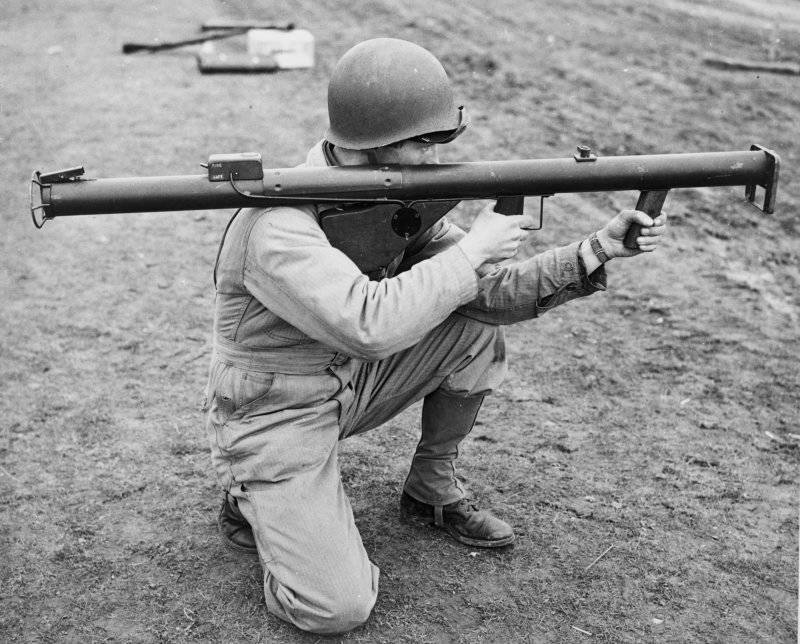
For firing from "Bazuki" was intended a rocket-propelled grenade, which received the designation M6. Its length was 540 mm, and weight - 1550 g. The first version of the grenade had a streamlined head and a pen stabilizer. At a temperature of + 20 ° C, the jet engine accelerates the grenade to 83 m / s. Sights were designed for the 183 m range. For training purposes, a M7A1 rocket grenade with an inert head part was used. In order for the mass and ballistics of the training grenade to match the combat variant, a metal rod was screwed into the fuse point. Training grenade fully painted black.
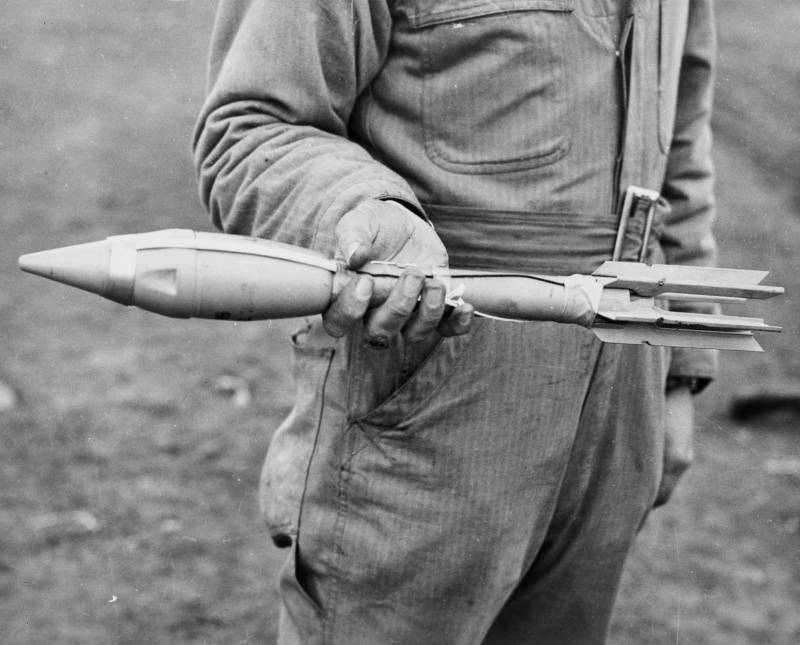
Fire from a grenade launcher with a mass of 8 kg was conducted by one soldier, but loading the weapon was quite difficult. For this, the breaker lever of the safety box was moved to the “SAFE” position.
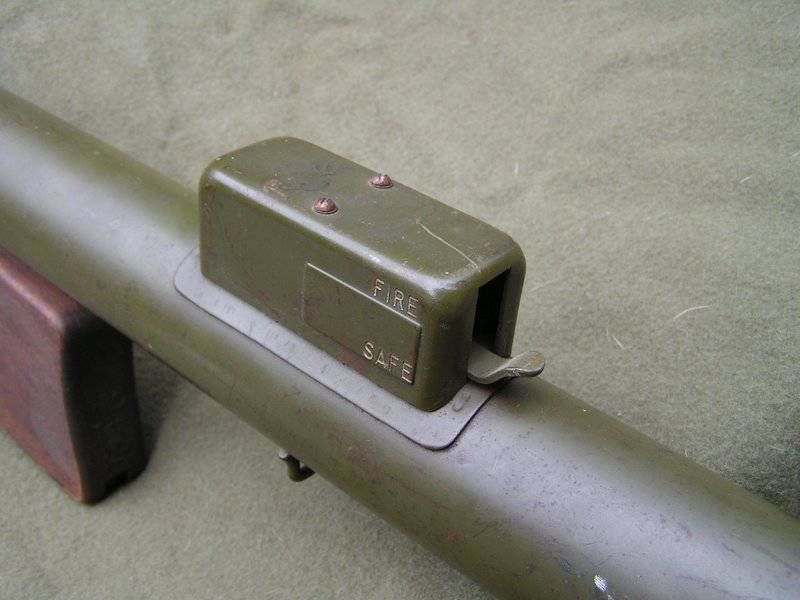
Charging, squeezing the spring-loaded latch with one hand, with the other hand inserting a grenade into the pipe and removing the safety check, then releasing the latch, which had to jump over the notch on the stabilizer. Before the shot, the breaker lever was raised to the “FIRE” position, after which the contact rod touched the contact ring on the grenade.
After completing the loading process of the Bazuki, the second member of the calculation had to leave the danger zone that formed behind the weapon when fired, and also make sure that there are no other servicemen, easily inflammable objects and ammunition. The danger zone behind the grenade launcher was 25 m. Due to the fact that often there was an incomplete combustion of a powder charge in the barrel, the calculation for avoiding burns was forced to use gloves and gas masks without filters. A well-trained and well-functioning calculation could make the 10 sighting shots per minute. If necessary, the loading of a grenade launcher and firing could be carried out by one fighter, but at the same time the rate of fire decreased by about three times. The calculation of the “Bazooka” of two people using special M6 bags or vests of the M1 mortar can carry nine 60-mm rocket grenades. Usually the shooter carried the 2-3, and the charging 6 rocket launcher shots.
The baptism of Bazooka took place during Operation Torch, a landing in North Africa that began on November 8 on the 1942 of November. However, grenade launchers gained recognition later - in the spring of 1943. In Tunisia, grenade launchers confidently hit German and Italian medium tanks. At a range of 110 m, the shooting accuracy was satisfactory, and a well-trained rocket launcher, with no strong side wind, was likely to hit the frontal projection of the tank.
The American infantry received a really effective and inexpensive anti-tank weapon, although not without significant flaws. Most complaints were caused by the electric ignition system of a reactive charge. Dry batteries had the ability to discharge at the most inopportune moment, and in wet weather the discharge rate increased several times. Calculations of grenade launchers complained about the inconvenience of carrying a long "pipe". At first, due to the imperfections of the reactive charge, when firing grenades of the early series in hot weather there were ruptures of the barrel, and in the cold powder did not have time to burn completely in the table, and the jet flow affected the calculation. That is, the rate of combustion of fuel in a jet engine depended too much on the ambient temperature. The M6 reactive grenade stabilizers were easily deformed, which had a negative effect on the firing accuracy. In addition, it was revealed that the streamlined shape of the head part of the grenade increased the tendency to rebound, which, in combination with the not too reliable operation of the inertial fuse, reduced the probability of hitting the target.
But still the merits of a new anti-tank weapon outweighed the disadvantages. The American industry has manufactured 112 790 grenade launchers of the first modification, which was facilitated by low cost and simple design. By the end of 1943, there were three Bazuki in the infantry company in the heavy weapons platoon section. Each infantry unit should have two shooters trained in the use of grenade launchers. Themselves anti-tank grenade launchers issued from the platoon of heavy weapons, if necessary. Another seven "Bazook" was in the company of heavy weapons infantry battalion and eight - in the staff company. Thus, the personnel of the infantry battalion could use a grenade launcher against enemy 24 tanks. A significant number of rocket-propelled anti-tank grenade launchers were available in other parts as well. For example, each 105-mm or 155-mm howitzer artillery division received 1943 "Bazook" according to March 40 of the year, according to the states. By the spring of 1944, the American units in Europe were adequately saturated with anti-tank rocket launchers, which of course had an impact on the course of the hostilities.
In July, the 1943 of the year adopted the upgraded version of the M1А1 grenade launcher and the improved M6А1 rocket launcher. Due to the modified recipe for solid fuel charge, it was possible to achieve a more stable rate of its combustion. Also to improve the reliability of the redesigned wiring. While maintaining the same length, the mass of the M1А1 grenade launcher was reduced by 1,2 kg. To prevent ruptures, the part of the trunk in the area from the ring in the rear section of the pipe to the middle of the shoulder rest was reinforced with a steel wire winding. To protect the shooter from the effects of gunpowder gases in the front section of the barrel, a protective screen of fine-meshed metal mesh was installed, twice the diameter of the barrel.
Massive deliveries of M1А1 grenade launchers to the US Army began by the time they landed in Normandy. All in all, 59 932 grenade launchers modification М1А1 were produced. Back in 1943, during the battles in Italy, it turned out that the Bazooka was unable to penetrate the frontal armor of heavy German tanks. In addition, the Germans began to actively install protivokumulyatnye screens for late modifications of medium tanks Pz.Kpfw.IV and SAU, produced on their base. In this regard, the military forced the development of a new version of the grenade launcher and more effective cumulative ammunition.
In the summer of 1944, the first units of the M9 grenade launcher arrived in combat units operating in Europe. Compared with the modifications М1 and М1А1, the combat and operational properties of the weapon have been significantly improved. In the model, officially referred to as the 2,36-inch Rocket launcher M9, tried to eliminate the main disadvantages of the previous samples. The new grenade launcher was partially made of a light alloy, which made it possible to lengthen the barrel to 1550 mm without increasing the mass. Unreliable and overly sensitive to climatic factors batteries were replaced by a more reliable induction generator mounted in the pistol grip. On the left side of the handle a convenient safety mechanism switch appeared. The wooden shoulder rest was replaced with a light aluminum frame-type focus, and a socket appeared instead of a protective screen. The rejection of the protective screen was due to the fact that the powder charge of a jet engine was now completely burned in an elongated barrel. Instead of simple mechanical sighting devices, an optical sight with a scale marked at a distance from 46 to 540 m was placed on a folding base to the left of the barrel.
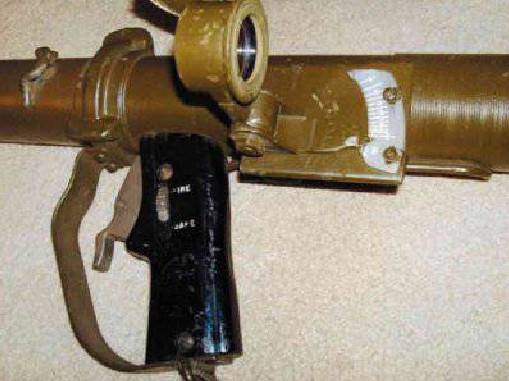
However, the effective firing range of the grenade launcher remained the same as in the earlier versions, and at the maximum range of 540 m only large area targets could be fired.
Specially for the airborne units in June 1944, a collapsible version of the M9-1 with a reinforced rear part of the pipe was created. Since the reinforcement was made by winding with steel wire, the weight of the weapon was 7,2 kg. In total, the armed forces took the 26087 M9 and 27781 M9А1 grenade launchers.
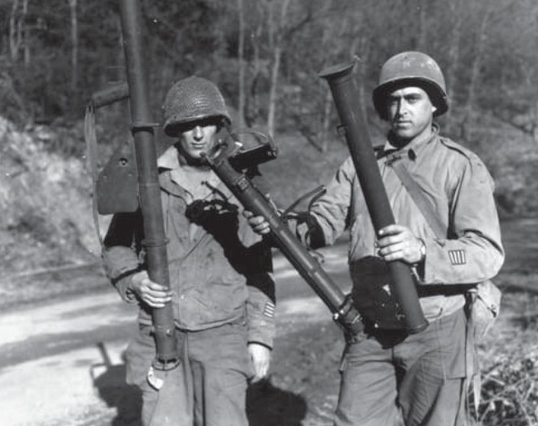
Along with the improvement of the grenade launcher and improved ammunition. The M6А1 and М6А2 rocket grenades had a modified electric pilot circuit and a stronger tail tail. At the end of 1944, the production of the M6AZ radically improved cumulative grenade began. New grenade outwardly very different from earlier samples.
To reduce the likelihood of a rebound, the head part has an oval shape. And the feather stabilizer that caused many complaints was replaced by a more durable and convenient cylindrical one when loading. The warhead M6A3 contained 230 g of pentolite, and the rocket engine was equipped with 65 g of gunpowder. Thanks to the increased explosive charge and the replacement of the steel lining of the cumulative recess with copper armor penetration, it was possible to bring up to 100 mm. The length of the grenade was 475 mm, and the mass was 1530 g. After the combustion of the powder charge, the grenade left the barrel at a speed of 85 m / s. The effective range remained the same - up to 110 m. Since the Bazookas in the troops were very often used against manpower, long-term firing points and in street battles it was necessary to expand the range of ammunition. For the M1A1, M9 and M9A1 grenade launchers, fragmentation and incendiary grenades equipped with white phosphorus, as well as smoke with charges of red, yellow, purple and green, were used for target designation aviation and artillery.
In the autumn of 1944, the American paratroopers fighting in the southern regions of France, testing the M9A1 grenade launchers in battle, noted the increased combat effectiveness and ease of handling. In the first months of 1945, the Bazooka М9 and М9А1 practically pushed out the М1 and М1А1 from the line infantry and airborne units. At the same time, in the management, supply and service units, the M1 and M1А1 grenade launchers were in service until the end of the war.
In May, the 1945 of the year began production of the latest batch version of the 60-mm Bazuki - M18. In this sample, which was released in just the number of 500 specimens, a more durable aluminum alloy was used to make the back of the barrel. This reduced the weight of the grenade launcher by more than two kilograms and increased the corrosion resistance in a humid tropical climate. Externally, the M18 differed from the M9 in a conical socket instead of a wire ring; the telescopic sight received a rubber eyecup and a protective cover.
Separately, it is worthwhile to dwell on the combat use of the Bazuk. After the landing of the Allies in Normandy, the brunt of the fight against German tanks fell on American and British fighter-bombers. In the conditions of air supremacy of the Allied aviation, a few German tanks did not always have time to even reach the front line. If German armored vehicles nevertheless appeared on the battlefield, then it was opposed by numerous PT-ACS M10 Wolverine, armed with an 90-mm gun, also 57 and 76-mm towed anti-tank guns М1 and М5. Therefore, the positions of the American infantry units German tanks rarely traveled. But given the high saturation of the "Bazookas" of the American troops (in the summer 1944 infantry division there were at least 557 anti-tank grenade launchers) combat incidents against tanks took place, of course.
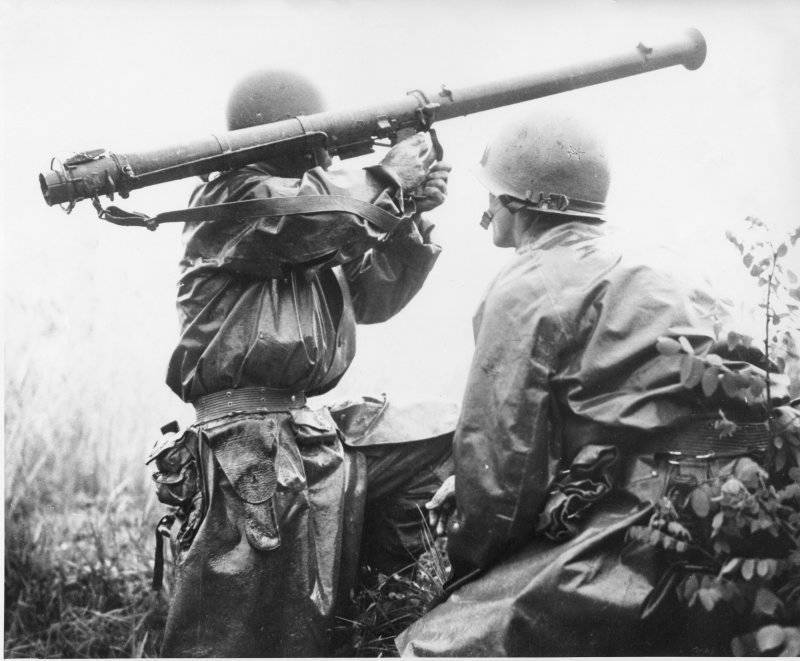
60-mm grenade launchers are quite justified. After the appearance of the M9 and M9A1 models with an induction electrical trigger system, the weapon became quite reliable. But even after the introduction of high-performance grenades M6А3, the heavy German Tiger and Panther tanks could only be hit in the side. At the same time, the Bazooka successfully pierced the frontal 80 mm of the armor of the Quartet, which was the most massive German tank until the end of the war. In the Pacific theater, the Bazuki missiles easily hit any Japanese tanks. The matter was facilitated by the fact that there were few tanks in parts of the Imperial Army that defended the Pacific Islands and they were used separately. In addition, dense vegetation made it possible for the grenade launchers to mask well and fire from the dagger’s distance. However, in battles with the Japanese, rocket-propelled grenade launchers were most often used not against armored vehicles, but for the destruction of enemy firing points and manpower. Several hundred captured American grenade launchers were used by the Germans. It is believed that Offenrohr and Panzerschreck rocket launchers were created after becoming acquainted with the captured "Bazouks" in Germany. A copy of the M1А1 grenade launcher was made in Hungary under the designation M.44.
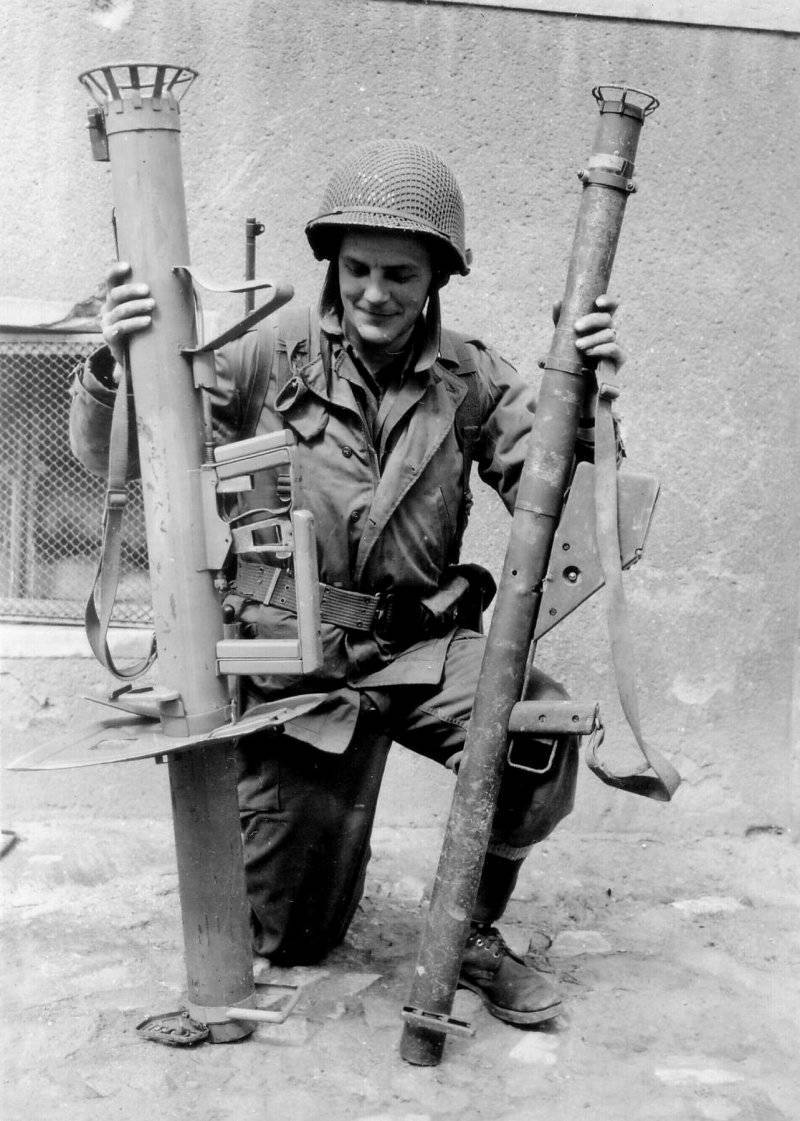
American soldier with M1А1 grenade launchers and German Panzerschreck. With almost the same length, there is a significant difference in the caliber
In Japan, in the middle of 1944, they adopted their counterpart, known as "Type 4". Unlike the Bazuki, a mechanical trigger mechanism was used in the 70-mm Japanese grenade launcher, and the stabilization of the grenade on the trajectory was carried out by rotation, due to the expiration of powder gases from oblique nozzles. Since during rotation the centrifugal force “splashed” the cumulative jet, armor penetration when the projectile met with armor at right angles did not exceed 60 mm, which was not enough to guarantee penetration of the frontal armor of the M4 Sherman tank.
According to American data, in 1943, the 3000 grenade launchers of the first production version of the M1 and 8500 missiles were sent to the USSR. Soviet experts noted the low reliability of the weapon, which was primarily due to the imperfection of the reactive charge ignition circuitry. At temperatures below -10 ° C, the electric battery lasted very briefly. It is possible that the American Bazuki, set up under the Lend-Lease, were still used on the Soviet-German front, but we could not find any data confirming this.
In addition to the Soviet Union, various Bazook models were shipped to the UK and China. They were armed with French formatting, battling with the Nazis. After the end of the Second World War, later modifications of the Bazuki became widespread in the armies of pro-American states. After the war, "Bazooka" has become synonymous with anti-grenade launcher. American anti-tank rocket launchers, developed during the war, spread throughout the world and were actively used until the end of the 70-s.
The first major conflict after the end of World War II, where the M9А1 and М18 grenade launchers were massively involved, was the war on the Korean Peninsula. American historians are very fond of justifying the military failures of the American and South Korean troops at the initial stage of hostilities with the helplessness of 60-mm grenade launchers against the Soviet T-34-85 medium tanks. Given that this weapon was successfully used to combat the German medium tanks PzKpfw IV of later modifications that were better protected in a frontal projection and quite reliably penetrated 80 mm onboard heavy Tiger armor, such claims seem dubious. Moreover, in 1945, the production of the improved M6AZ / C reactive grenade began, capable of penetrating the normal 120 mm of homogeneous armor. As you know, the frontal armor of the hull of the T-34-85 was 45 mm. Given the inclination of the frontal armor at an angle 45 °, we can assume that it was equivalent to 60 mm homogeneous armor installed at right angles. Provided reliable fuse operation, and on advanced M6А3 grenades, not inclined because of the shape of the head to ricoche, the fuse was quite reliable, the frontal body armor of the thirty-four body had to be easily penetrated, and the cumulative jet had a good zaronev effect. This is confirmed by the fact that KPA soldiers with trophy 60-mm Bazooks often penetrated the frontal armor of American Sherman tanks, whose forehead was 51 mm thick, with an angle of inclination 56 ° - that is, about the same 60 mm under direct angle of
Moreover, the American heavy tanks M26 Pershing in some cases were also vulnerable to "ineffective" anti-tank grenade launchers against the T-34-85. The thickness of the upper frontal armor plate on the "Pershing" was 102 mm with the angle of inclination 46 °, and the lower one - 76 mm, at an angle 53 °. The maximum thickness of the side armor of the M26 tank - 76 mm - that is significantly more than the forehead of the T-34-85 hull.
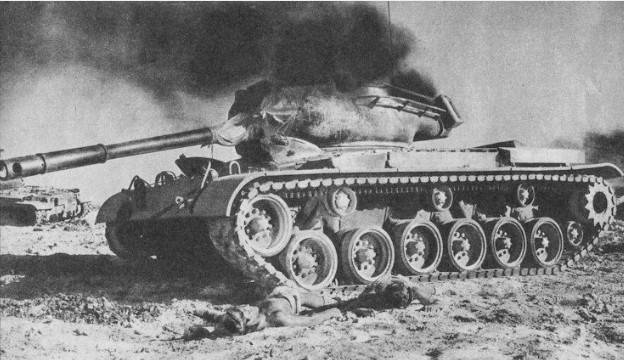
Obviously, the matter is not the insufficient armor penetration of 60-mm cumulative grenades, but the unwillingness of American and South Korean soldiers to fight a well-motivated opponent in the initial period of the conflict, who had a sufficiently modern weapon by the standards of that time.
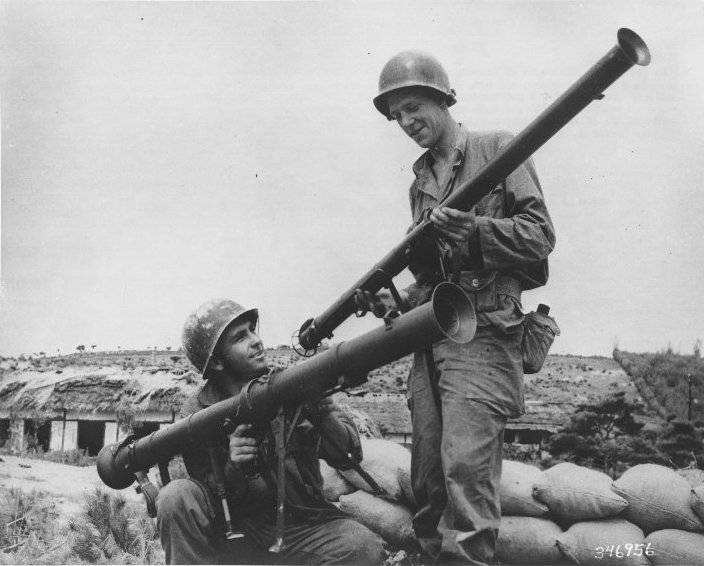
Although 60-mm M9X1 and M18 grenade launchers were officially recognized as “ineffective” and “obsolete” in the American army, this weapon was used by all parties to the conflict until the armistice in 1953 was relatively low. But since the war soon took a protracted positional character, and the use of tanks was difficult because of the terrain, rocket launchers were often used to destroy firing points. In this respect, the more compact and lightweight M9A1 and M18 had the advantage over 88,9-mm M20. To sneak up on the distance of an effective shot at a bunker with an 60-mm pipe was much easier.
After a collision with the “thirty-fours,” 88,9-mm M20 grenade launchers were sent to the US military contingent in Korea. At the end of July, 1950, the first batch of grenade launchers was hastily delivered by air from the United States along with instructors. Simultaneously with the rearmament of the American and South Korean soldiers, they were “run in” with tanks in order to eliminate “tank fear”.
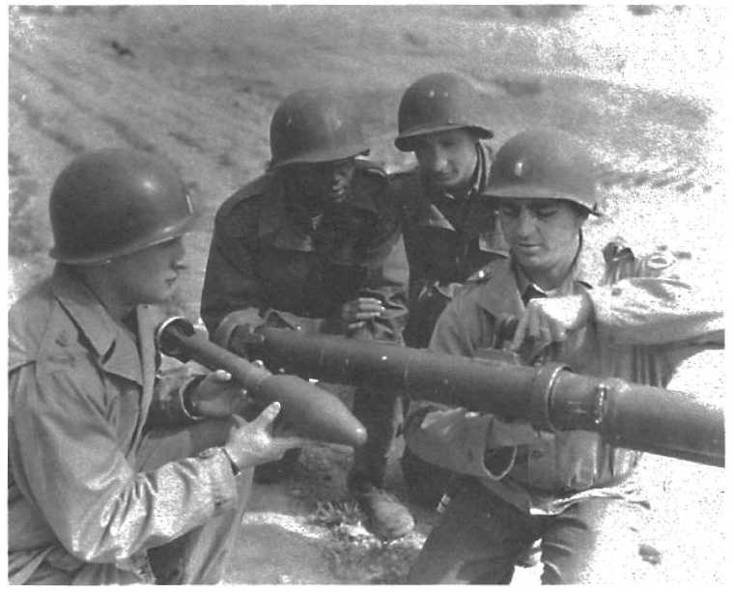
Although the 88,9-mm anti-tank grenade launcher, also known as the “Super-Bazooka”, was put into service in October 1945, its mass production due to the end of hostilities and the presence in the troops and warehouses of large stocks of 60-mm “Bazuk” began only in 1950 year.
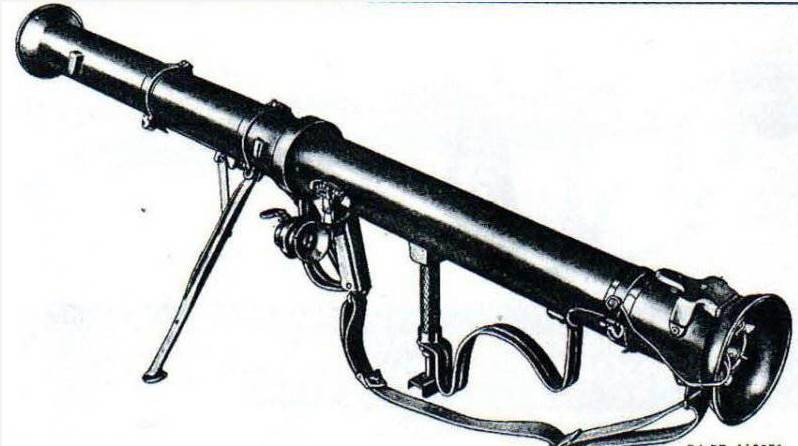
In connection with the growth of the caliber, armor penetration and effective range significantly increased. At the same time, the combat rate of fire in comparison with the M9A1 decreased by half and amounted to 4-5 in units per minute. Weight 88,9-mm M20 grenade launcher in the combat position - 11 kg, in the stowed position - 6,8 kg.
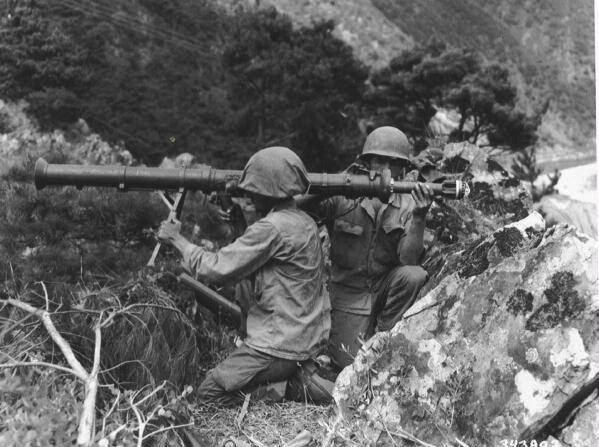
For ease of use in a combat position there were bipods adjustable in height, an additional handle and shoulder rest, and the protective brace and trigger were enlarged, which made it possible to work in warm gloves. The metal pipe in which the monopod was placed served as a part of the aluminum shoulder rest of the frame type, fixed under the rear part of the barrel.
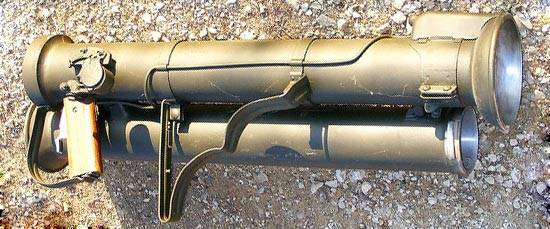
The trunk of the “Super-Bazooka” with a length of 1524 mm for weight reduction was made of aluminum alloy and disassembled when carried in two parts, each with a length of 762 mm. The mass of the front and rear parts of the trunk on different versions differed. On lightweight models М20А1 and М20А1В1, respectively, it was 2 and 4,4 kg, and 1,8 and 4,1 kg. Lightweight modifications: M20A1 (weight 6,4 kg) and M20A1B1 (weight 5,9 kg) appeared after the end of the Korean War. The reduction in the mass of weapons occurred due to the rejection of the bipod and the monopod.
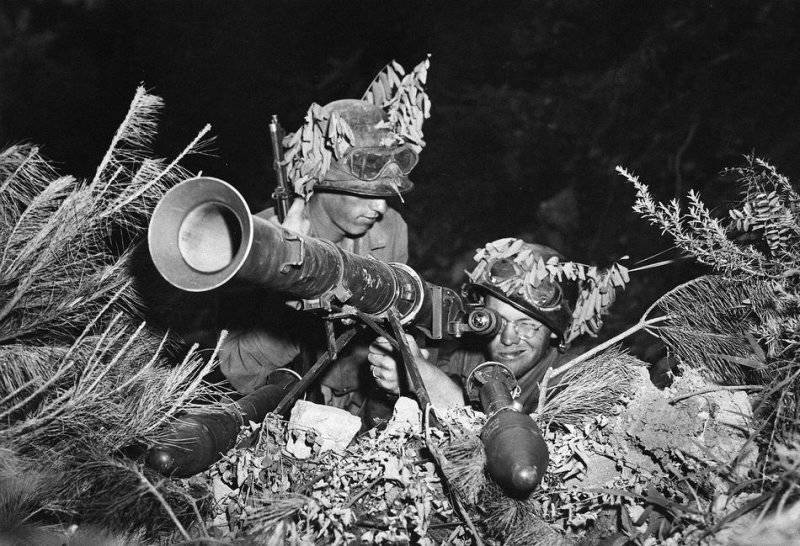
For shooting from the “Super-Bazuki” several types of rocket-propelled grenades were created: cumulative, smoke and training with inert filling of the head part. The cumulative 88,9-mm grenade M28A2 weighing 4080 g contained 850 g of explosive Composition B (a mixture of hexogen and trotyl in the ratio 64 / 36) and normally pierced 280 mm armor. Thus, the American infantry had the opportunity to effectively combat not only the Thirty-Fours, but also the more advanced T-54 medium tanks, whose mass production began in the 1948 year.
In TNT equivalent, the explosive charge contained in a cumulative grenade was about 1 kg, which made it possible to effectively use M28A2 grenades against fortifications and manpower. The initial speed of the grenade, depending on the temperature of the reactive charge was 103-108 m / s. Ground targets could be fired at a distance of up to 800 m.

In addition to the cumulative, the ammunition consisted of a smoke grenade T127E3 / M30 WP equipped with 1060 g of white phosphorus. Officially, the main purpose of this munition was the installation of smoke screens and target designation. When the warhead broke, the scatter radius of burning white phosphorus reached 20 m, which made the grenade an effective incendiary tool. In the anti-tank and phosphate grenades used the same inertial fuses M404A1 or M404A2. Training grenade M29A2 with a head part filled with plaster in ballistics, size and weight did not differ from the cumulative and smoke. All rocket grenades had the same length - 598 mm.
However, due to the increase in size and weight of the 88,9-mm rocket-propelled grenade ammunition, carried by a two-person calculation, was reduced to 4 shots. Specially for the purpose of increasing the ammunition ready for use, two additional members of the calculation were introduced into the calculation - carriers of ammunition, and for transportation of grenades they created a special backpack in which six grenades were placed in closures. The weight of the load was 27 kg. However, in practice, the fighters preferred to carry a minimum of cargo, and rear services were engaged in the transport of spare ammunition.
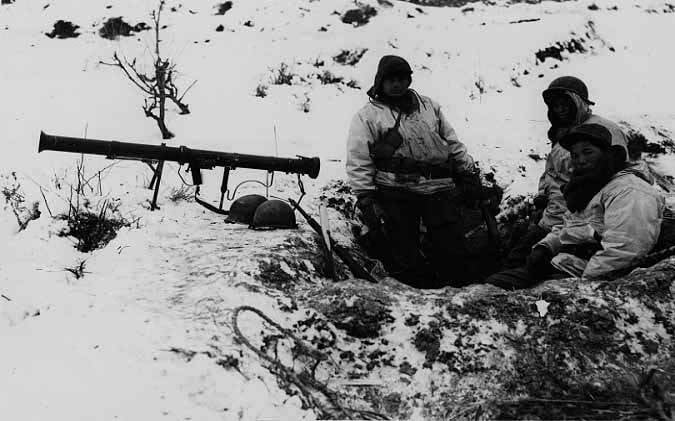
Due to their good service, operational and combat characteristics, the grenade launchers of the M20 family are widely used. During the Korean War, one “Super Bazooka” was introduced into each infantry unit of the US Army. In the American infantry division at the end of 1953, the 465 "Super Bazook" was in service, in the division of the South Korean army - 258 grenade launchers. In the US KMP, 88,9-mm anti-tank grenade launchers were located in the assault sections of the rifle company weapons platoons. In each section, there were six calculations of three people in each. By the beginning of the 1960-x in each regiment of the Marine Corps was on 98 М20А1В1.
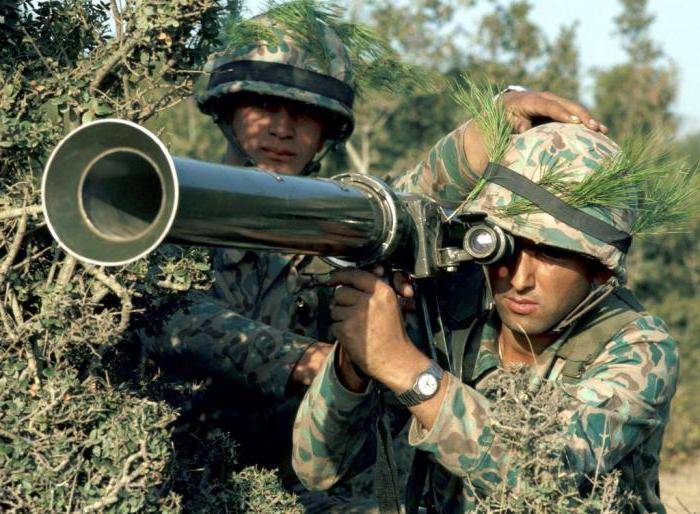
In the regular American divisions, "Super Bazooka" were used until the mid-60-s, and in the National Guard - until the beginning of the 70-s. 88,9-mm anti-tank grenade launchers were actively transferred to the allies and were officially in service in more than 40 states. Austria, Spain and Japan produced their own, slightly modified versions of a grenade launcher. In the middle of the 50-x production M20 was established in China. The unlicensed Chinese version is known as "Type 54". In the 60s, 88,9-mm anti-tank grenade launchers were manufactured in Cuba. Chinese and Cuban copies of Super Bazooka were widely supplied to all kinds of rebel movements in Africa, Asia and Latin America.
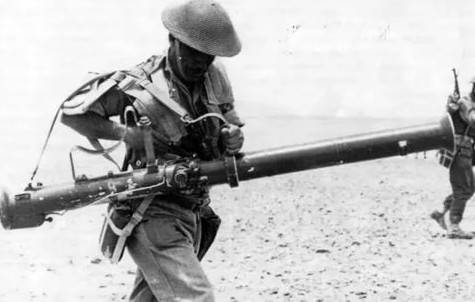
Chinese-made Type 54 grenade launchers were popular with the Vietnamese partisans. Although at the disposal of the Vietnamese in the 60-s there were Soviet RPG-2 grenade launchers, and from the beginning of the 70-x and more advanced RPG-7, the Chinese "Type 54" and captured М20А1В1 were used until the end of hostilities. Until the middle of the 70s of the last century, until the Soviet RPG-7 gained widespread distribution, becoming the "Kalashnikov" among anti-tank grenade launchers, 60 and 88,9-mm American grenade launchers and their clones were the most massive anti-tank infantry weapons. Although in most countries of the world obsolete grenade launchers are decommissioned, “Super-Bazuki” can still be found in the armies of the “third world” states and in the arsenals of various kinds of irregular formations.
To be continued ...
Based on:
https://www.forgottenweapons.com/browning-m2-anti-mechanization-weapon/
https://www.militaryfactory.com/smallarms/detail.asp?smallarms_id=906
http://www.koreanwaronline.com/history/Guidebook/Pages1/RifleGrenades.htm
https://www.syl.ru/article/365178/chto-takoe-bazuka-foto-opisanie-konstruktsiya-orujiya
https://second-world-war-hu.webnode.hu/
http://tankarchives.blogspot.ru/2017/12/super-bazooka-improved-antitank-fist.html
http://shooting-iron.ru/load/223-1-0-291
http://wwii.space/granatyi-ssha/
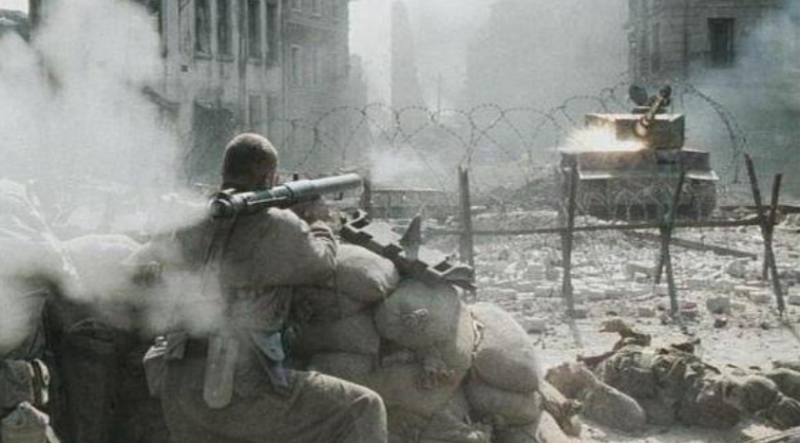
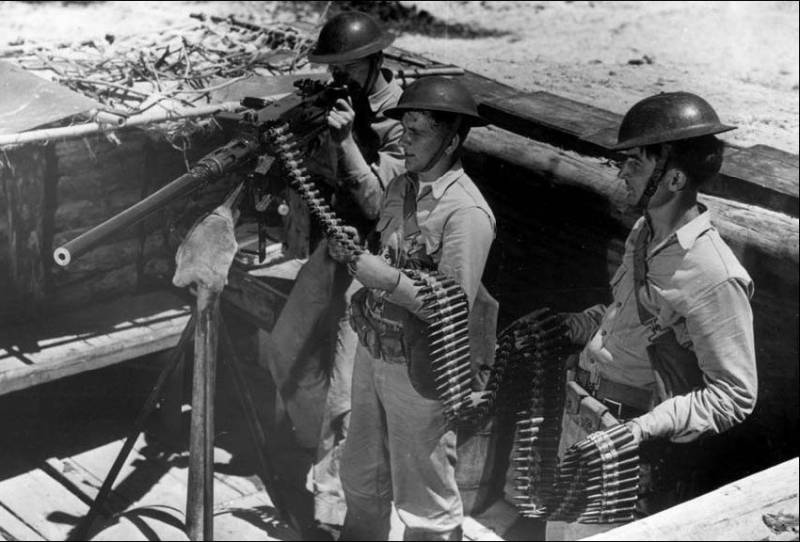
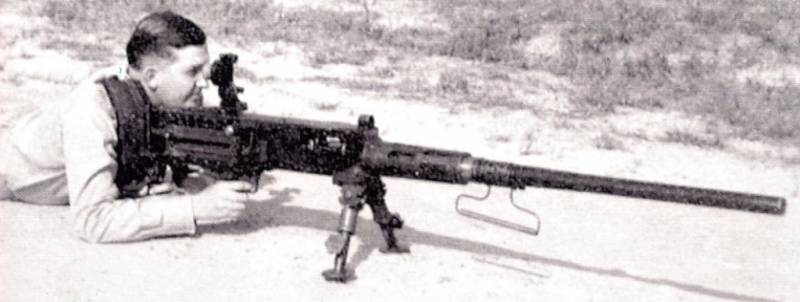
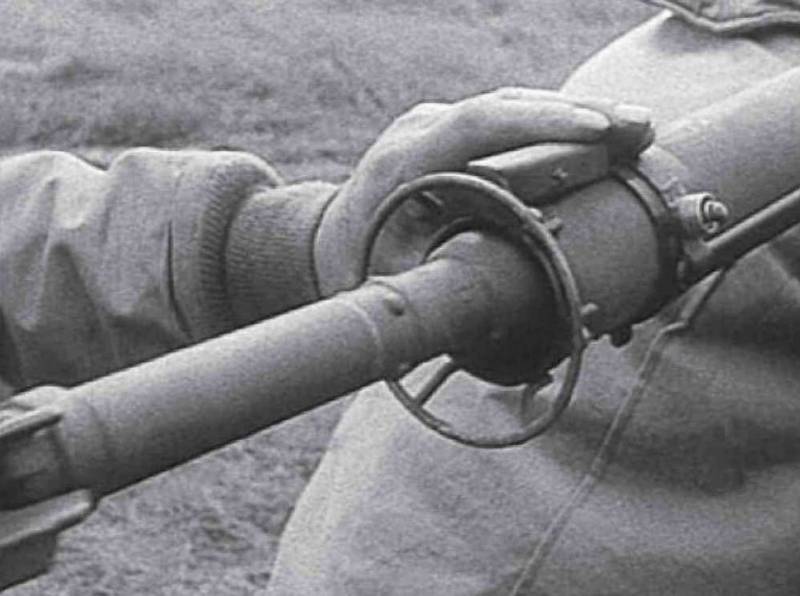
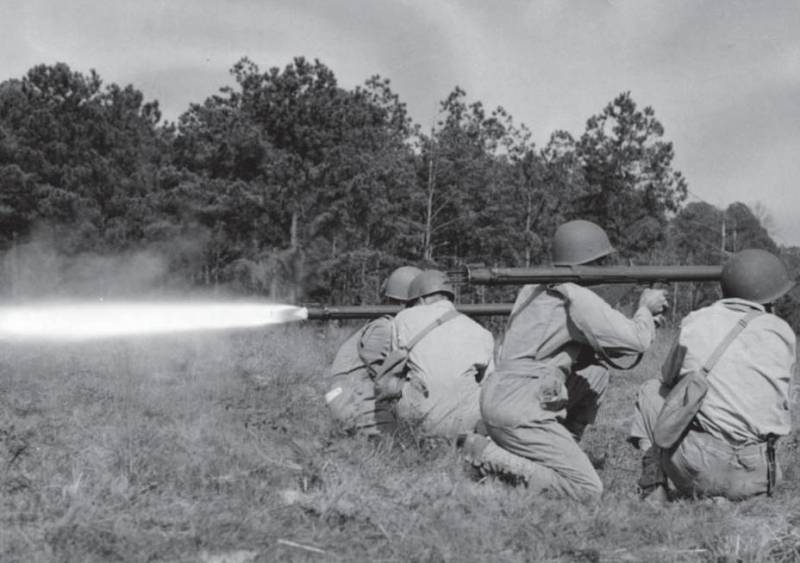
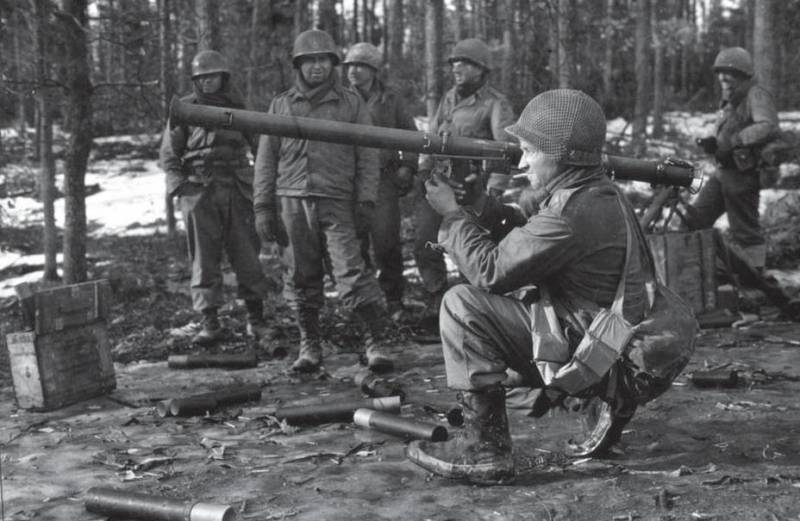

Information